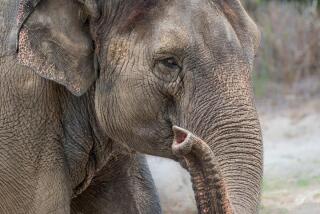A $2.55 elephant encounter in Thailand

It was, unquestionably, the best $2.55 I’ve ever spent on vacation.
For less than the cost of a Double Whopper, I spent a day in the company of 55 whoppers -- domesticated Asian elephants being rehabbed after lives of labor. No chains, no enclosures, often no distance at all from behemoths within touching range.
For an animal lover like me, it was a pachyderm paradise for the price of peanuts.
As for the elephants, it was probably just another routine day at the 300-acre Elephant Conservation Center in northern Thailand. As part of their schedule, the elephants performed in 45-minute shows that displayed their former tasks, such as hauling logs, and newfound skills, which include painting abstract art that has sold for thousands of dollars at fundraising auctions. After showtimes, the elephants sauntered down a dirt road for a dip in a lagoon.
Beyond the organized activities, there was plenty to see at the center, which is 45 miles southeast of Chiang Mai, the largest city in northern Thailand. The conservation center draws more than 10,000 Thai children annually and a steady stream of elephant-centric tourists.
At an outdoor nursery, three moms were keeping an eye on their calves, ranging from 5 months to 1 year old. Nearby was a veterinary hospital where visitors could see animals being treated.
Among the tidbits I picked up on my November visit, part of a 2 1/2-week trip to Southeast Asia:
* Elephants purr. Not to imply it’s a 3-ton kitty, but as my hand touched the side of an adult female, I felt and then heard a low, vibrating sound, like a well-tuned truck engine idling. I learned the sound was originally thought to be a function of digestion but is now seen as a way that elephants communicate with one another.
* Baby elephants have erratic control of their trunks. In a fenced but largely open and spacious enclosure, a mom and an infant were receptive to visitors. A 1-year-old calf named Phreyanood woke up from a snooze and wandered over for a treat or to be scratched. The calf then subjected my upper torso to a bumpy body scan, clumsily tapping the end of its trunk against my face, chest and arms, sort of “how’s it going” pokes. Zoologists estimate an elephant’s trunk has up to 100,000 small muscles; a guide at the compound speculated that Phreyanood was still getting the hang of the trunk and that I was a guinea pig.
* When a fully grown elephant raises its head and trumpets 50 feet from a group of Thai schoolchildren on a field trip, those kids jump high and scatter fast.
There are thought to be up to 600,000 elephants worldwide, but only about 10% are Asian elephants. They’re closer genetically to the extinct woolly mammoth than to the African elephant. About 4,000 Asian elephants are thought to exist in Thailand, about half of those domesticated.
Elephants are Thailand’s national symbol; outside of Buddhas, elephants are the country’s main visual icon, from carvings on palaces and temples to images plastered on souvenirs.
The use of elephants as domesticated animals trained for labor is intertwined with the development of Thai civilization. The animals are especially associated with the Thai monarchy; kings kept rare white elephants as signs of wealth, potency and power.
Thai elephants have faced a modern economic quandary: unemployment. In 1989, the nation banned commercial logging of teak in its northern forests, and that left as many as 3,000 domesticated elephants, trained to drag logs and goods through mountainous terrain, and their mahouts (trainers) whose livelihood depends on the elephants) jobless.
Of the several elephant training camps that have opened, some are nothing more than dubious sideshows, where the elephants carry tourists up to 12 hours a day and perform potentially injurious stunts. Other governmental facilities are more like wildlife refuges, where visitor interaction is kept to a minimum.
The conservation center strikes a balance. It’s operated by the national Forest Industry Organization, the branch of the government responsible for elephants, and is run by energetic co-founder Prasop Tippasert.
“For Thais, especially children, it is important they understand the spirit of these elephants,” Tippasert said.
The facility was created, he said, to take care of elephants and their mahouts. “At the beginning, I knew nothing about tourism or marketing,” he said.
Tippasert, 52, has definitely learned. Now, for instance, visitors can book multiday stays to train as guest mahouts, living on the grounds and working with one of the animals and its full-time mahout.
Dara Molloy, 26, of Dublin, Ireland, was doing an immersion stay. After a show in the compound arena with his elephant Patchoop (“She can’t make out my accent, so I’m saying, ‘Ketchup,’ and that’s working for her”), his eyes shone with excitement.
“It’s 6 a.m. to 6 p.m., you clean them, feed them, do the shows, go on forest walks. . . . You do everything!” Molloy said.
“Everything” for Molloy included a bath and a ride atop Patchoop into, then under the water. When they came up, at least one of them was exhilarated.
“From far away, they look like lumbering beasts, but close up they’re fluid,” Molloy said. “It’s a privilege being here with her,” Molloy said. “I’d wish it for anyone who loves elephants.”
Not to mention anyone who loves a travel bargain.
More to Read
Sign up for The Wild
We’ll help you find the best places to hike, bike and run, as well as the perfect silent spots for meditation and yoga.
You may occasionally receive promotional content from the Los Angeles Times.





